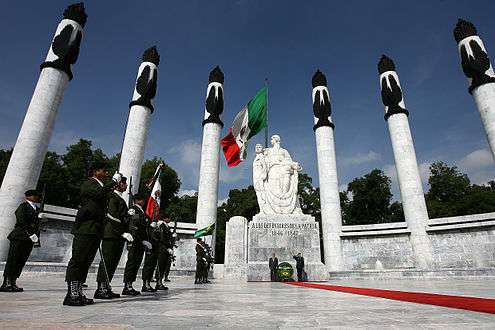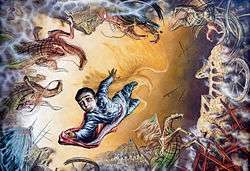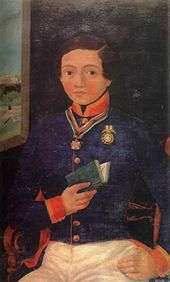Niños Héroes

The Niños Héroes (Spanish: [ˈniɲos ˈeɾoes], Boy Heroes), also known as the Heroic Cadets or Boy Soldiers, were six Mexican teenage military cadets. These cadets died defending Mexico City's Chapultepec Castle from invading U.S. forces in the 13 September 1847 Battle of Chapultepec, during the Mexican–American War. According to legend, in an act of bravery, Juan Escutia wrapped the Mexican flag around his body and jumped from the top of the castle in order to keep it from falling into the hands of the Americans.[2]
The Niños Héroes are a key part of Mexico's patriotic folklore, commemorated by a national holiday on September 13. However, several modern Mexican historians claim that parts of the story are not factual.[2][3]
History

Chapultepec Castle served as the Mexican Army's military academy. It was defended by Mexican troops under the command of Nicolás Bravo, including cadets from the academy. The number of cadets present has been variously given, from 47[4] to a few hundred. The greatly outnumbered defenders battled General Winfield Scott's troops for about two hours before General Bravo ordered retreat, but the six cadets refused to fall back and fought to the death. Legend has it that the last of the six, Juan Escutia, leapt from Chapultepec Castle wrapped in the Mexican flag to prevent the flag from being taken by the enemy. According to the later account of an unidentified US officer, "about a hundred" cadets between the ages of 10 and 16 were among the "crowds" of prisoners taken after the Castle's capture.[5]
Biographies

Juan de la Barrera was born in 1828 in Mexico City, the son of Ignacio Mario de la Barrera, an army general, and Juana Inzárruaga. He enlisted at the age of 12 and was admitted to the Academy on 18 November 1843. During the attack on Chapultepec he was a lieutenant in the military engineers (sappers) and died defending a gun battery at the entrance to the park. Aged 19, he was the oldest of the six, and was also part of the school faculty as a volunteer teacher in engineering.
Juan Escutia was born between 1828 and 1832 in Tepic, now the capital of the state of Nayarit. Records show he was admitted to the Academy as a cadet on 8 September 1847—five days before the fateful battle—but his other papers were lost during the assault. He is often portrayed as a second lieutenant in an artillery company. He is the cadet who supposedly wrapped himself up in the Mexican flag and jumped from the roof to keep it from falling into enemy hands. His body was found on the east flank of the hill, alongside that of Francisco Márquez.

Francisco Márquez was born in 1834 in Guadalajara, Jalisco. Following the death of his father, his mother, Micaela Paniagua, remarried Francisco Ortiz, a cavalry captain. He applied to the Academy on 14 January 1847 and, at the time of the battle, belonged to the first company of cadets. A note included in his personnel record says his body was found on the east flank of the hill, alongside that of Juan Escutia. At 13 years old, he was the youngest of the six heroes.
Agustín Melgar was born between 1828 and 1832 in Chihuahua, Chihuahua. He was the son of Esteban Melgar, a lieutenant colonel in the army, and María de la Luz Sevilla, both of whom died while he was still young, leaving him the ward of his older sister. He applied to the Academy on 4 November 1846. A note in his personnel record explains that after finding himself alone, he tried to stop the enemy on the north side of the castle.
Fernando Montes de Oca was born between 1828 and 1832 in Azcapotzalco, then a town just to the north of Mexico City and now one of the boroughs of the Federal District. His parents were José María Montes de Oca and Josefa Rodríguez. He had applied to the Academy on 24 January 1847, and was one of the cadets who remained in the castle. His personnel record reads: "Died for his country on 13 September 1847."
Vicente Suárez was born in 1833 in Puebla, Puebla, the son of Miguel Suárez, a cavalry officer, and María de la Luz Ortega. He applied for admission to the Academy on 21 October 1845, and during his stay was an officer cadet.
Memorials
An obelisk (pictured) was erected in 1881 to commemorate the Battle of Chapultepec. Interest in the battle increased in 1947, the hundred-year anniversary.
On March 5 of that year, U.S. President Harry S. Truman placed a wreath at the monument and stood for a few moments of silent reverence. Asked by American reporters why he had gone to the monument, Truman said, "Brave men don't belong to any one country. I respect bravery wherever I see it."[6][7]
The same year, a mass grave was found on the southern hillside of Chapultepec Hill. Six bodies were officially identified as belonging to the six deceased cadets of 1847. The bodies were exhumed and placed in urns on September 13 and a plaque was placed at the site.[8] The authenticity of the remains is in dispute, since there appears to have been no identification based on forensic science or anthropology.[9][3]
On September 27, 1952, after many public ceremonies, a monument was inaugurated in the Plaza de la Constitución (Zócalo) with an honor guard from the several military academies of the Americas. The six cadets are honored by an imposing monument made of Carrara marble by architect Enrique Aragón and sculptor Ernesto Tamariz at the entrance to Chapultepec Park (1952).[1] This semicircular monument with six columns, placed at what was the end of the old Walk of the Emperor (today known as the Paseo de la Reforma or the Walk of the Reformation), contains a niche in each of its columns with an urn holding the remains of one of the cadets. In addition, the remains of Colonel Felipe Santiago Xicoténcatl[10][11] were placed in the center of the monument below the main statue.
The monument is dedicated to the combatants against the United States invasion with the phrase: “To the Defenders of the Fatherland 1846-1847”. The monument's official name is Altar a la Patria (Altar to the Homeland), but it is better known as the Monumento a los Niños Héroes (Monument to the Boy Heroes) and many official texts use the popular name instead of the official name.[12]
At the castle itself, in 1967 Gabriel Flores painted a large mural above the stairway depicting Escutia's jump from the roof with the Mexican flag.
The 5000-peso banknote (1987 series) commemorated the battle. The cadets are shown and named on the front of the banknote, and the Chapultepec castle is on the reverse. Starting in 1993, this banknote was retired in favor of the 5 nuevos pesos coin, and there is no analogous banknote in the 1996 series. The cadets appear on a N$50 coin minted from 1993; it is rare compared to the N$50 banknote.
The name Niños Héroes, along with the cadets' individual names, are commonly given to streets, squares and schools across Mexico. Metro Niños Héroes is the name of a station on the Mexico City Metro, as well as a station on the Monterrey Metro. Streets in the Condesa neighborhood adjacent to Chapultepec Castle bear the names of each cadet who took part.[13]
References
- 1 2 Espínola, Lorenza. "Los Niños Héroes, un símbolo" (in Spanish). Comisión Organizadora de la Conmemoración del Bicentenario del inicio del movimiento de Independencia Nacional y del Centenario del inicio de la Revolución Mexicana. Retrieved 2009-05-09.
- 1 2 inter alia, Villalpando, José Manuel; Niños Héroes, México DF: Planeta, 2004; Hernández Silva, HC: "¿Quién aventó a Juan Escutia?", La Jornada, December 13, 1998; Rosas, Alejandro "Una historia mal contada: Los Niños Héroes", Relatos e Historias en México, year II No. 13, September 2009.
- 1 2 Herrera-Sobek, María (2012). Celebrating Latino Folklore: An Encyclopedia of Cultural Traditions, Volume 1. ABC-CLIO. p. 856. ISBN 9780313343391. Retrieved March 5, 2017. She called "the biggest blow to the credibility of the boy heroes" a 2009 report of INEHRM (National Institute for the Historic Study of Mexico's Revolutions): "Por el honor de México". Archived from the original on 2011-01-02. Retrieved 2017-12-30. (Spanish)
- ↑ Miller, Robert Ryal (1989). Mexico: A History. University of Oklahoma Press. p. 228. ISBN 978-0-8061-2178-9.
- ↑ Mansfield, Edward Deering (1849). The Mexican War (10 ed.). New York: A.S. Barnes & Co. p. 298.
- ↑ McCullough, David (1993) Truman. New York: Simon & Schuster.
- ↑ David McCullough's account of Truman's visit to the monument in 1947.
- ↑ Casasola Zapata, Gustavo (1992). Historia Gráfica de la Revolución Mexicana 1900-1970. México: Editorial Trillas S.A. de C.V. p. 2611 a 2615.
- ↑ Van Wagnenen, Michael (2012). Remembering the Forgotten War: The Enduring Legacies of the U.S./Mexican War (illustrated ed.). Amherst: University of Massachusetts Press. ISBN 9781558499294. Retrieved March 5, 2017.
- ↑ "Obelisco a los Niños Héroes". Chapultepec Forest Commission. Retrieved 2017-09-06.
- ↑ "ALTAR A LA PATRIA". Mexico City Government, Tourism Secretariat. Retrieved 2017-09-06.
- ↑ Rodriguez O., Jaime E.; Vincent, Kathryn, eds. (June 1, 1997). Myths, Misdeeds, and Misunderstandings: The Roots of Conflict in U.S.-Mexican Relations (1st ed.). Rowman & Littlefield Publishers. p. 99. ISBN 978-0842026628. Retrieved March 5, 2017.
- ↑ Roma Condesa map, Mexico City Tourism Department
External links
